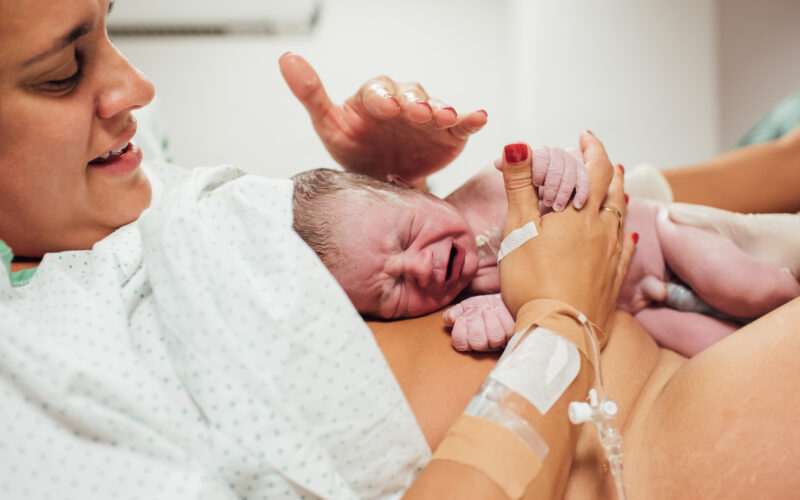When you picture someone in the midst of giving birth, what comes to mind? You might imagine a woman lying on her back in a hospital bed, in considerable distress. While I wanted to avoid this scenario at all costs, it’s where I found myself with my first baby. I was swept along by hospital staff who were used to doing things a certain way. I ended up with agonizing second-degree tears that took weeks to heal, and resolved to do what I could to make sure things went differently with my next baby. The second time around, I found a midwife I could trust. I gave birth in a kneeling position supported by my husband. My second stage of labor was fast, with only superficial tearing and a vastly easier recovery. I now know that birthing position(s) actually can impact how you and your baby handle delivery. Here I’ll cover the best position for birthing to avoid tearing, the problems with giving birth on your back, and your birthing position options even if you have an epidural.
Birthing positions overview
Evidence Based Birth has an excellent comprehensive article on the research evidence around different birthing positions. I’ll give you a briefer rundown here.
Birthing positions fall into two general categories: reclined and upright. Reclined positions include back-lying, lithotomy position (birthing on one’s back with feet in stirrups or held up by someone else) and semi-sitting (laying back in an elevated position). While side-lying is also a reclined position, it does not share the drawbacks that the other reclined positions carry. I’ll explain why in detail later on.
Upright positions include standing, kneeling, hands-and-knees, squatting, or using a birth chair. Many women find changing positions to be a helpful strategy, especially if the pushing phase is long, and different birthing positions can be used even if you have an epidural!
Back is best? Not for birthing!
The benefits of back-lying birth positions aren’t for mom (or baby)
The benefits of reclined birthing positions (other than side-lying) like back-lying or lithotomy position are mostly for your healthcare team. Back-lying positions make electronic fetal monitoring easier and give the delivering provider easy access to your baby in the event of a complication. Most healthcare providers are used to and have been trained in assisting with women giving birth in back-lying positions.
Back-lying also does not require anyone to physically support you, which is a factor in hospitals with staffing concerns. Because of these factors, medical staff sometimes pressure women to give birth on their backs. However, choosing your birthing position is a legal right (see also here and a 2016 court decision here)[1]. Forcing you to give birth in a certain position is defined as obstetric violence.
Drawbacks of birthing on your back
Although back-lying positions are convenient for medical personnel, there are serious downsides for you and maybe for your baby. Lying on your back puts a lot of weight on your spine and the surrounding muscles and blood vessels. This pressure can compress your aorta and decrease blood flow for both you and your baby. Remember how doctors always say not to lay on your back after the first trimester? That’s why! This can contribute to fetal distress, drop your blood pressure, and make it difficult for your uterus to contract effectively.
Back-lying positions also put weight on your tailbone and prevent your pelvic area from expanding during birth the way it normally would in an upright or side-lying position. Because of this, according to Evidence-Based Birth, there is an increased risk of needing interventions, such as forceps, episiotomy, vacuum assistance, or even an unplanned Cesarean section.
Back-lying positions are associated with higher rates of perineal tearing, partly because of the increased likelihood of instrument-assisted birth, but also because the weight of the baby’s head is placed squarely on your perineum during the birth. The perineum is the space between your anus and vagina. More upright positions will help to distribute the pressure of your baby’s head more evenly around your vulvo-vaginal ring (the opening of the birth canal) and exert less relative pressure on your perineum [2].
Side-lying birthing positions
So, does this mean lying down is out of the question for giving birth? Absolutely not! Lying on your side takes pressure off your aorta and allows your tailbone to move freely. Side-lying is a great option for women who are exhausted after a long labor. It’s also great for women who are feeling particularly numb from an epidural and would have difficulty getting into an upright position.
Furthermore, side-lying can slow down labor, giving time for the skin and muscles to stretch and help prevent tearing. A 2012 study of women who had epidurals found that those who birthed in side-lying position with delayed pushing had fewer tears compared to those who birthed in lithotomy position and pushed right away once they fully dilated [3].
Upright birthing positions
Upright positions include standing, kneeling, hands-and-knees, squatting, or using a birthing chair. In upright positions, gravity helps to bring the baby down the birth canal, meaning less work for mama and baby. Upright positions also help keep the aorta free from compression, let the tailbone move to allow more space for the baby’s head to pass through, help the uterus contract more efficiently, and are associated with less pain. Evidence Based Birth compiled results from different studies on upright birthing positions that found these positions were also associated with lower rates of shoulder dystocia (baby’s shoulder getting stuck in the birth canal), abnormal fetal heart tones, and emergency C-sections.
Best positions to give birth in to avoid severe tears
Avoiding stitches, longer recovery, and potential complications? Yes, please! Certainly, a variety of risk factors can contribute to severe tears. These include the baby’s head size, which direction the baby is situated in the birth canal, if Pitocin has been used, and whether the mom experiences a prolonged second stage of labor. But position also makes a significant difference [2].
Tear rates are higher for first-time moms, no matter your position
A 2015 Swedish study looked at the risk for severe tears with different birthing positions and compared the rates of severe (3rd or 4th degree) tears for first-time moms (nulliparous) versus moms who had delivered before (parous) [2]. This study only looked at the position the baby was actually delivered in. It didn’t study which positions the moms labored in during earlier pushing contractions.
Researchers found that for first-time moms, the rates were lowest for standing, side-lying, squatting, back-lying, sitting, and hands-and knees (in that order). Severe tear rates were highest with a birth seat and in the lithotomy position.
For seasoned moms, the rates were lowest for standing, side-lying, back-lying, and sitting (in that order). Rates were higher in hands-and-knees, using a birth seat, squatting, and the lithotomy position. Of note, the likelihood of severe tears with any of those positions was significantly lower than for first-time moms. The study authors commented that the higher rates of tears with birth seats and squatting positions could be explained by the fact that women tend to deliver very quickly in these positions. In these cases the perineum may not have time to stretch slowly. This could lead to tearing. To slow delivery of the baby’s head and hopefully prevent tearing, the Bradley Method recommends the following: Once the baby’s head begins to crown, don’t push. Breathe slowly [4].
And the winner for best position to give birth in to decrease severe tears is…
Standing and side-lying had the lowest rates of severe tears for both nulliparous and parous women. These may be the best positions to give birth in to avoid severe vaginal tears. Remember, though: the Swedish study focused on 3rd and 4th degree tears. But it stands to reason that utilizing perineum-friendly positions leads to fewer less-severe tears as well.
I plan on having an epidural: what are my position options?
Giving birth on your back is often a default position for women with an epidural. This makes some sense since turning, especially without someone else’s help, can be difficult when you lack sensation in the lower half of your body. But women who have an epidural still have options. Sure, if you have concerns about falling in a certain position because of a lack of feeling in your lower body, then that is not a safe position for delivery. And, hospitals may have rules around epidurals that would prohibit positions that involve getting out of bed, such as standing.
At the very least, though, side-lying is a good position to keep you off of your back. Many women are also able to comfortably utilize sitting (some hospital beds break down to allow for this position), kneeling with support (such as a birthing ball), or hands-and-knees.
If having full range of motion is a priority, consider that natural birth might be your best option!
Final reminders about pushing and birth positions to avoid tearing
Remember, mama: you have the right to give birth in a manner and position that feels right for you. Evidence suggests multiple ways to decrease your risk of complications like perineal tearing during pushing and birth. Try different positions–especially upright positions–in the second stage of labor, since there’s no one best position to give birth in to avoid tearing. Avoid giving birth on your back (especially prioritize standing and side-lying). And when you push, push in a way that feels natural.
Take time to prepare and find a provider who supports your goals for birth, so you can feel more empowered and more able to stick with your plan even when labor starts to feel like a lot. You’ve got this!
If you’ve been dreading laying in a hospital bed while making a herculean effort to deliver your baby–don’t! There are easier, more evidence-based, and safer options out there. Take courage in rejecting the status quo and try positions that feel right for you.
References:
[1] Stohl, Hindi. “Childbirth Is Not a Medical Emergency: Maternal Right to Informed Consent throughout Labor and Delivery.” The Journal of legal medicine vol. 38,3-4 (2018): 329-353. doi:10.1080/01947648.2018.1482243 [2] Elvander, C., Ahlberg, M., Thies-Lagergren, L. et al. “Birth position and obstetric anal sphincter injury: a population-based study of 113 000 spontaneous births.” BMC Pregnancy Childbirth 15, 252 (2015). https://doi.org/10.1186/s12884-015-0689-7 [3] Walker, Carolina et al. “Alternative model of birth to reduce the risk of assisted vaginal delivery and perineal trauma.” International urogynecology journal vol. 23,9 (2012): 1249-56. doi:10.1007/s00192-012-1675-5 [4] McCutcheon, Susan. Natural Childbirth the Bradley Way. Plume: 2018. p. 174 [5] Simpson KR. When and how to push: providing the most current information about second-stage labor to women during childbirth education. J Perinat Educ. 2006 Fall;15(4):6-9. doi: 10.1624/105812406X151367. PMID: 17768429; PMCID: PMC1804305.Additional Reading:
Yes, perineal massage might sound weirdly “crunchy.” Here’s why you should consider it anyway
The 6 things every woman considering a natural childbirth should know







